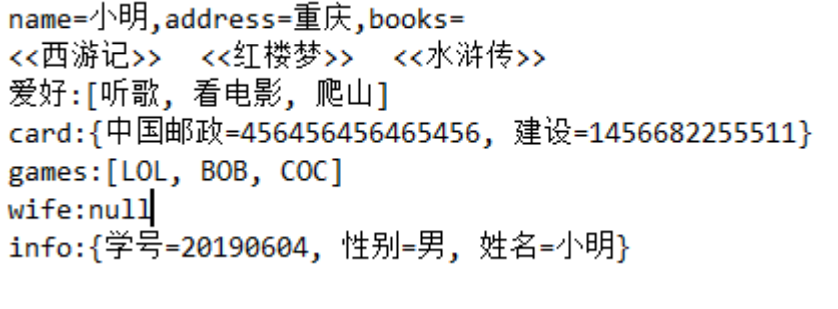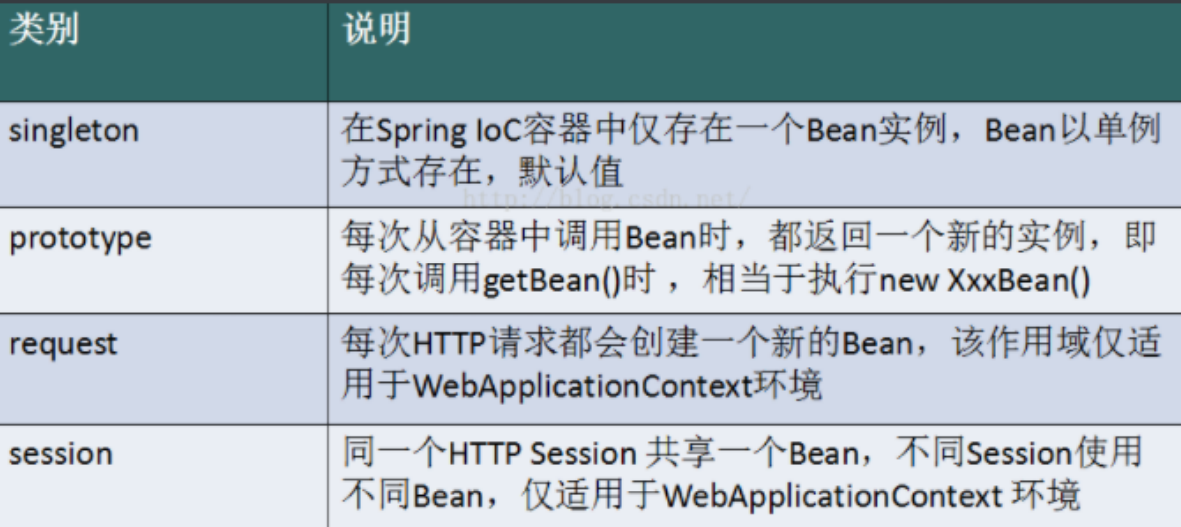Spring配置
1. 别名
alias 设置别名 , 为bean设置别名 , 可以设置多个别名
<!--设置别名:在获取Bean的时候可以使用别名获取--> <alias name=\"userT\" alias=\"userNew\"/>
2. Bean的配置
<!--bean就是java对象,由Spring创建和管理-->
<!--
id 是bean的标识符,要唯一,如果没有配置id,name就是默认标识符
如果配置id,又配置了name,那么name是别名
name可以设置多个别名,可以用逗号,分号,空格隔开
如果不配置id和name,可以根据applicationContext.getBean(.class)获取对象;
class是bean的全限定名=包名+类名
-->
<bean id=\"hello\" name=\"hello2 h2,h3;h4\" class=\"com.kuang.pojo.Hello\">
<property name=\"name\" value=\"Spring\"/>
</bean>
3. import
团队的合作通过import来实现 .
<import resource=\"{path}/beans.xml\"/>
依赖注入(DI)
- 依赖注入(Dependency Injection,DI)。
- 依赖 : 指Bean对象的创建依赖于容器 . Bean对象的依赖资源 .
- 注入 : 指Bean对象所依赖的资源 , 由容器来设置和装配 .
1 构造器注入
在上一篇博客已经详细讲过了
2 set注入 (重点)
要求被注入的属性 , 必须有set方法 , set方法的方法名由set + 属性首字母大写 , 如果属性是boolean类型 , 没有set方法 , 是 is .
测试pojo类 :
Address.java
public class Address {
private String address;
public String getAddress() {
return address;
}
public void setAddress(String address) {
this.address = address;
}
}
Student.java
package com.hang.pojo;
import java.util.List; import java.util.Map; import java.util.Properties; import java.util.Set;
public class Student { private String name; private Address address; private String[] books; private List<String> hobbys; private Map<String,String> card; private Set<String> games; private String wife; private Properties info;
public void setName(String name) { this.name = name; }
public void setAddress(Address address) { this.address = address; }
public void setBooks(String[] books) { this.books = books; }
public void setHobbys(List<String> hobbys) { this.hobbys = hobbys; }
public void setCard(Map<String, String> card) { this.card = card; }
public void setGames(Set<String> games) { this.games = games; }
public void setWife(String wife) { this.wife = wife; }
public void setInfo(Properties info) { this.info = info; }
public void show(){ System.out.println(\"name=\"+ name + \",address=\"+ address.getAddress() + \",books=\" ); for (String book:books){ System.out.print(\"<<\"+book+\">>\\t\"); } System.out.println(\"\\n爱好:\"+hobbys); System.out.println(\"card:\"+card); System.out.println(\"games:\"+games); System.out.println(\"wife:\"+wife); System.out.println(\"info:\"+info); } }
2、1 常量注入
<bean id=\"student\" class=\"com.kuang.pojo.Student\">
<property name=\"name\" value=\"小明\"/>
</bean>
测试:
@Test
public void test01(){
ApplicationContext context = new ClassPathXmlApplicationContext(\"applicationContext.xml\");
Student student = (Student) context.getBean(\"student\");
System.out.println(student.getName());
}
2、2 Bean注入
注意点:这里的值是一个引用,ref
<bean id=\"addr\" class=\"com.kuang.pojo.Address\"> <property name=\"address\" value=\"重庆\"/> </bean>
<bean id=\"student\" class=\"com.kuang.pojo.Student\"> <property name=\"name\" value=\"小明\"/> <property name=\"address\" ref=\"addr\"/> </bean>
2、3 数组注入
<bean id=\"student\" class=\"com.kuang.pojo.Student\"> <property name=\"name\" value=\"小明\"/> <property name=\"address\" ref=\"addr\"/> <property name=\"books\"> <array> <value>西游记</value> <value>红楼梦</value> <value>水浒传</value> </array> </property> </bean>
2、4 List注入
<property name=\"hobbys\"> <list> <value>听歌</value> <value>看电影</value> <value>爬山</value> </list> </property>
2、5 Map注入
<property name=\"card\"> <map> <entry key=\"中国邮政\" value=\"456456456465456\"/> <entry key=\"建设\" value=\"1456682255511\"/> </map> </property>
2、6 set注入
<property name=\"games\"> <set> <value>LOL</value> <value>BOB</value> <value>COC</value> </set> </property>
2、7 Null注入
<property name=\"wife\"><null/></property>
2、8 Properties注入
<property name=\"info\"> <props> <prop key=\"学号\">20190604</prop> <prop key=\"性别\">男</prop> <prop key=\"姓名\">小明</prop> </props> </property>
测试结果:

3 拓展注入实现
User.java : 【注意:这里没有有参构造器!】
public class User {
private String name;
private int age;
public void setName(String name) {
this.name = name;
}
public void setAge(int age) {
this.age = age;
}
@Override
public String toString() {
return \"User{\" +
\"name=\'\" + name + \'\\\'\' +
\", age=\" + age +
\'}\';
}
}
1、P命名空间注入 : 需要在头文件中假如约束文件
导入约束 : xmlns:p=\"http://www.springframework.org/schema/p\" <!--P(属性: properties)命名空间 , 属性依然要设置set方法--> <bean id=\"user\" class=\"com.kuang.pojo.User\" p:name=\"腹白\" p:age=\"18\"/>
2、c 命名空间注入 : 需要在头文件中假如约束文件
导入约束 : xmlns:c=\"http://www.springframework.org/schema/c\" <!--C(构造: Constructor)命名空间 , 属性依然要设置set方法--> <bean id=\"user\" class=\"com.kuang.pojo.User\" c:name=\"腹白\" c:age=\"18\"/>
发现问题:爆红了,刚才我们没有写有参构造!
解决:把有参构造器加上,这里也能知道,c 就是所谓的构造器注入!
测试代码:
@Test
public void test02(){
ApplicationContext context = new ClassPathXmlApplicationContext(\"applicationContext.xml\");
User user = (User) context.getBean(\"user\");
System.out.println(user);
}
4 Bean的作用域
在Spring中,那些组成应用程序的主体及由Spring IoC容器所管理的对象,被称之为bean。简单地讲, bean就是由IoC容器初始化、装配及管理的对象 .

几种作用域中,request、session作用域仅在基于web的应用中使用(不必关心你所采用的是什么web 应用框架),只能用在基于web的Spring ApplicationContext环境。
4.1 Singleton
当一个bean的作用域为Singleton,那么Spring IoC容器中只会存在一个共享的bean实例,并且所有对 bean的请求,只要id与该bean定义相匹配,则只会返回bean的同一实例。Singleton是单例类型,就是 在创建起容器时就同时自动创建了一个bean的对象,不管你是否使用,他都存在了,每次获取到的对象 都是同一个对象。注意,Singleton作用域是Spring中的缺省作用域。要在XML中将bean定义成 singleton,可以这样配置:
<bean id=\"ServiceImpl\" class=\"cn.csdn.service.ServiceImpl\" scope=\"singleton\">
测试:
@Test
public void test03(){
ApplicationContext context = new ClassPathXmlApplicationContext(\"applicationContext.xml\");
User user = (User) context.getBean(\"user\");
User user2 = (User) context.getBean(\"user\");
System.out.println(user==user2);
}
4.2 Prototype
当一个bean的作用域为Prototype,表示一个bean定义对应多个对象实例。Prototype作用域的bean会 导致在每次对该bean请求(将其注入到另一个bean中,或者以程序的方式调用容器的getBean()方法) 时都会创建一个新的bean实例。Prototype是原型类型,它在我们创建容器的时候并没有实例化,而是 当我们获取bean的时候才会去创建一个对象,而且我们每次获取到的对象都不是同一个对象。根据经 验,对有状态的bean应该使用prototype作用域,而对无状态的bean则应该使用singleton作用域。在 XML中将bean定义成prototype,可以这样配置:
<bean id=\"account\" class=\"com.foo.DefaultAccount\" scope=\"prototype\"/> 或者 <bean id=\"account\" class=\"com.foo.DefaultAccount\" singleton=\"false\"/>
4.3 Request
当一个bean的作用域为Request,表示在一次HTTP请求中,一个bean定义对应一个实例;即每个HTTP 请求都会有各自的bean实例,它们依据某个bean定义创建而成。该作用域仅在基于web的Spring ApplicationContext情形下有效。考虑下面bean定义:
<bean id=\"loginAction\" class=cn.csdn.LoginAction\" scope=\"request\"/>
针对每次HTTP请求,Spring容器会根据loginAction bean的定义创建一个全新的LoginAction bean实 例,且该loginAction bean实例仅在当前HTTP request内有效,因此可以根据需要放心的更改所建实例 的内部状态,而其他请求中根据loginAction bean定义创建的实例,将不会看到这些特定于某个请求的 状态变化。当处理请求结束,request作用域的bean实例将被销毁。
4.4 Session
当一个bean的作用域为Session,表示在一个HTTP Session中,一个bean定义对应一个实例。该作用域 仅在基于web的Spring ApplicationContext情形下有效。考虑下面bean定义:
<bean id=\"userPreferences\" class=\"com.foo.UserPreferences\" scope=\"session\"/>
针对某个HTTP Session,Spring容器会根据userPreferences bean定义创建一个全新的 userPreferences bean实例,且该userPreferences bean仅在当前HTTP Session内有效。与request作 用域一样,可以根据需要放心的更改所创建实例的内部状态,而别的HTTP Session中根据 userPreferences创建的实例,将不会看到这些特定于某个HTTP Session的状态变化。当HTTP Session 最终被废弃的时候,在该HTTP Session作用域内的bean也会被废弃掉。
Bean的自动装配
- 自动装配是使用spring满足bean依赖的一种方法
- spring会在应用上下文中为某个bean寻找其依赖的bean。
Spring中bean有三种装配机制,分别是:
- 在xml中显式配置;
- 在java中显式配置;
- 隐式的bean发现机制和自动装配。
这里我们主要讲第三种:自动化的装配bean。
Spring的自动装配需要从两个角度来实现,或者说是两个操作:
- 组件扫描(component scanning):spring会自动发现应用上下文中所创建的bean;
- 自动装配(autowiring):spring自动满足bean之间的依赖,也就是我们说的IoC/DI;
组件扫描和自动装配组合发挥巨大威力,使的显示的配置降低到最少。
推荐不使用自动装配xml配置 , 而使用注解 .
1、测试环境搭建
1. 新建一个项目
2. 新建两个实体类,Cat Dog 都有一个叫的方法
public class Cat {
public void shout() {
System.out.println(\"miao~\");
}
}
public class Dog {
public void shout() {
System.out.println(\"wang~\");
}
}
3. 新建一个用户类 User
public class User {
private Cat cat;
private Dog dog;
private String str;
}
4. 编写Spring配置文件
<?xml version=\"1.0\" encoding=\"UTF-8\"?> <beans xmlns=\"http://www.springframework.org/schema/beans\" xmlns:xsi=\"http://www.w3.org/2001/XMLSchema-instance\" xsi:schemaLocation=\"http://www.springframework.org/schema/beans http://www.springframework.org/schema/beans/spring-beans.xsd\">
<bean id=\"dog\" class=\"com.kuang.pojo.Dog\"/> <bean id=\"cat\" class=\"com.kuang.pojo.Cat\"/>
<bean id=\"user\" class=\"com.kuang.pojo.User\"> <property name=\"cat\" ref=\"cat\"/> <property name=\"dog\" ref=\"dog\"/> <property name=\"str\" value=\"qinjiang\"/> </bean> </beans>
5. 测试
public class MyTest {
@Test
public void testMethodAutowire() {
ApplicationContext context = new ClassPathXmlApplicationContext(\"beans.xml\");
User user = (User) context.getBean(\"user\");
user.getCat().shout();
user.getDog().shout();
}
}
结果正常输出,环境OK
2、byName
autowire byName (按名称自动装配)
由于在手动配置xml过程中,常常发生字母缺漏和大小写等错误,而无法对其进行检查,使得开发效率 降低。
采用自动装配将避免这些错误,并且使配置简单化。
测试:
1. 修改bean配置,增加一个属性 autowire=\"byName\"
<bean id=\"user\" class=\"com.kuang.pojo.User\" autowire=\"byName\">
<property name=\"str\" value=\"qinjiang\"/>
</bean>
2. 再次测试,结果依旧成功输出!
3. 我们将 cat 的bean id修改为 catXXX
4. 再次测试, 执行时报空指针java.lang.NullPointerException。因为按byName规则找不对应set方 法,真正的setCat就没执行,对象就没有初始化,所以调用时就会报空指针错误。
小结:
当一个bean节点带有 autowire byName的属性时。
- 将查找其类中所有的set方法名,例如setCat,获得将set去掉并且首字母小写的字符串,即cat。
- 去spring容器中寻找是否有此字符串名称id的对象。
- 如果有,就取出注入;如果没有,就报空指针异常。
3、byType
autowire byType (按类型自动装配)
使用autowire byType首先需要保证:同一类型的对象,在spring容器中唯一。如果不唯一,会报不唯一 的异常。
NoUniqueBeanDefinitionException
测试:
1. 将user的bean配置修改一下 : autowire=\"byType\"
2. 测试,正常输出
3. 在注册一个cat 的bean对象!
<bean id=\"dog\" class=\"com.kuang.pojo.Dog\"/> <bean id=\"cat\" class=\"com.kuang.pojo.Cat\"/> <bean id=\"cat2\" class=\"com.kuang.pojo.Cat\"/>
<bean id=\"user\" class=\"com.kuang.pojo.User\" autowire=\"byType\"> <property name=\"str\" value=\"qinjiang\"/> </bean>
4. 测试,报错:NoUniqueBeanDefinitionException
5. 删掉cat2,将cat的bean名称改掉!测试!因为是按类型装配,所以并不会报异常,也不影响最后 的结果。甚至将id属性去掉,也不影响结果。
这就是按照类型自动装配!
4 使用注解
jdk1.5开始支持注解,spring2.5开始全面支持注解。
准备工作: 利用注解的方式注入属性。
1. 在spring配置文件中引入context文件头
xmlns:context=\"http://www.springframework.org/schema/context\" http://www.springframework.org/schema/context http://www.springframework.org/schema/context/spring-context.xsd
2. 开启属性注解支持!
<context:annotation-config/>
4.1、@Autowired
- @Autowired是按类型自动转配的,不支持id匹配。
- 需要导入 spring-aop的包!
测试:
1. 将User类中的set方法去掉,使用@Autowired注解
public class User {
@Autowired
private Cat cat;
@Autowired
private Dog dog;
private String str;
public Cat getCat() {
return cat;
}
public Dog getDog() {
return dog;
}
public String getStr() {
return str;
}
}
2. 此时配置文件内容
<context:annotation-config/>
<bean id=\"dog\" class=\"com.kuang.pojo.Dog\"/> <bean id=\"cat\" class=\"com.kuang.pojo.Cat\"/> <bean id=\"user\" class=\"com.kuang.pojo.User\"/>
3. 测试,成功输出结果!
【科普】
@Autowired(required=false) 说明: false,对象可以为null;true,对象必须存对象,不能为null。
//如果允许对象为null,设置required = false,默认为true @Autowired(required = false) private Cat cat;
4.2、@Qualifier
- @Autowired是根据类型自动装配的,加上@Qualifier则可以根据byName的方式自动装配
- @Qualifier不能单独使用。
测试实验步骤:
1. 配置文件修改内容,保证类型存在对象。且名字不为类的默认名字!
<bean id=\"dog1\" class=\"com.kuang.pojo.Dog\"/> <bean id=\"dog2\" class=\"com.kuang.pojo.Dog\"/> <bean id=\"cat1\" class=\"com.kuang.pojo.Cat\"/> <bean id=\"cat2\" class=\"com.kuang.pojo.Cat\"/>
2. 没有加Qualifier测试,直接报错
3. 在属性上添加Qualifier注解
@Autowired @Qualifier(value = \"cat2\") private Cat cat; @Autowired @Qualifier(value = \"dog2\") private Dog dog;
4. 测试,成功输出!
4.3、@Resource
- @Resource如有指定的name属性,先按该属性进行byName方式查找装配;
- 其次再进行默认的byName方式进行装配;
- 如果以上都不成功,则按byType的方式自动装配。
- 都不成功,则报异常。
实体类:
public class User {
//如果允许对象为null,设置required = false,默认为true
@Resource(name = \"cat2\")
private Cat cat;
@Resource
private Dog dog;
private String str;
}
beans.xml
<bean id=\"dog\" class=\"com.hang.pojo.Dog\"/> <bean id=\"cat1\" class=\"com.hang.pojo.Cat\"/> <bean id=\"cat2\" class=\"com.hang.pojo.Cat\"/> <bean id=\"user\" class=\"com.hang.pojo.User\"/>
测试:结果OK
配置文件2:beans.xml , 删掉cat2
<bean id=\"dog\" class=\"com.kuang.pojo.Dog\"/> <bean id=\"cat1\" class=\"com.kuang.pojo.Cat\"/>
实体类上只保留注解
@Resource private Cat cat; @Resource private Dog dog;
结果:OK
结论:先进行byName查找,失败;再进行byType查找,成功。
5、小结
@Autowired与@Resource异同:
- @Autowired与@Resource都可以用来装配bean。都可以写在字段上,或写在setter方法上。
- @Autowired默认按类型装配(属于spring规范),默认情况下必须要求依赖对象必须存在,如果 要允许null 值,可以设置它的required属性为false,如:@Autowired(required=false) ,如果我 们想使用名称装配可以结合@Qualifier注解进行使用
- @Resource(属于J2EE复返),默认按照名称进行装配,名称可以通过name属性进行指定。如果 没有指定name属性,当注解写在字段上时,默认取字段名进行按照名称查找,如果注解写在 setter方法上默认取属性名进行装配。 当找不到与名称匹配的bean时才按照类型进行装配。但是 需要注意的是,如果name属性一旦指定,就只会按照名称进行装配。
它们的作用相同都是用注解方式注入对象,但执行顺序不同。@Autowired先byType,@Resource先 byName。
使用注解开发
1、说明
在spring4之后,想要使用注解形式,必须得要引入aop的包

在配置文件当中,还得要引入一个context约束
<?xml version=\"1.0\" encoding=\"UTF-8\"?> <beans xmlns=\"http://www.springframework.org/schema/beans\" xmlns:xsi=\"http://www.w3.org/2001/XMLSchema-instance\" xmlns:context=\"http://www.springframework.org/schema/context\" xsi:schemaLocation=\"http://www.springframework.org/schema/beans http://www.springframework.org/schema/beans/spring-beans.xsd http://www.springframework.org/schema/context http://www.springframework.org/schema/context/spring-context.xsd\">
</beans>
2、Bean的实现
我们之前都是使用 bean 的标签进行bean注入,但是实际开发中,我们一般都会使用注解!
1. 配置扫描哪些包下的注解
<!--指定注解扫描包--> <context:component-scan base-package=\"com.hang.pojo\"/>
2. 在指定包下编写类,增加注解
@Component(\"user\")
// 相当于配置文件中 <bean id=\"user\" class=\"当前注解的类\"/>
public class User {
public String name = \"腹白\";
}
3. 测试
@Test
public void test(){
ApplicationContext applicationContext = new ClassPathXmlApplicationContext(\"beans.xml\");
User user = (User) applicationContext.getBean(\"user\");
System.out.println(user.name);
}
3、属性注入
使用注解注入属性
1. 可以不用提供set方法,直接在直接名上添加@value(\"值\")
@Component(\"user\")
// 相当于配置文件中 <bean id=\"user\" class=\"当前注解的类\"/>
public class User {
@Value(\"秦疆\")
// 相当于配置文件中 <property name=\"name\" value=\"秦疆\"/>
public String name;
}
2. 如果提供了set方法,在set方法上添加@value(\"值\");
@Component(\"user\")
public class User {
public String name;
@Value(\"秦疆\")
public void setName(String name) {
this.name = name;
}
}
4、衍生注解
我们这些注解,就是替代了在配置文件当中配置步骤而已!更加的方便快捷!
@Component三个衍生注解
为了更好的进行分层,Spring可以使用其它三个注解,功能一样,目前使用哪一个功能都一样。
- @Controller:web层
- @Service:service层
- @Repository:dao层
写上这些注解,就相当于将这个类交给Spring管理装配了!
5、自动装配注解
在Bean的自动装配已经讲过了,可以回顾!
6、作用域
@scope
- singleton:默认的,Spring会采用单例模式创建这个对象。关闭工厂 ,所有的对象都会销毁。
- prototype:多例模式。关闭工厂 ,所有的对象不会销毁。内部的垃圾回收机制会回收
@Controller(\"user\")
@Scope(\"prototype\")
public class User {
@Value(\"秦疆\")
public String name;
}
7、小结
XML与注解比较
- XML可以适用任何场景 ,结构清晰,维护方便
- 注解不是自己提供的类使用不了,开发简单方便
xml与注解整合开发 :推荐最佳实践
- xml管理Bean
- 注解完成属性注入
- 使用过程中, 可以不用扫描,扫描是为了类上的注解
<context:annotation-config/>
作用:
- 进行注解驱动注册,从而使注解生效
- 用于激活那些已经在spring容器里注册过的bean上面的注解,也就是显示的向Spring注册
- 如果不扫描包,就需要手动配置bean
- 如果不加注解驱动,则注入的值为null!
8、基于Java类进行配置
JavaConfig 原来是 Spring 的一个子项目,它通过 Java 类的方式提供 Bean 的定义信息,在 Spring4 的 版本, JavaConfig 已正式成为 Spring4 的核心功能 。
测试:
1. 编写一个实体类,Dog
@Component //将这个类标注为Spring的一个组件,放到容器中!
public class Dog {
public String name = \"dog\";
}
2. 新建一个config配置包,编写一个MyConfig配置类
@Configuration //代表这是一个配置类
public class MyConfig {
@Bean //通过方法注册一个bean,这里的返回值就Bean的类型,方法名就是bean的id!
public Dog dog(){
return new Dog();
}
}
3. 测试
@Test
public void test2(){
ApplicationContext applicationContext = new AnnotationConfigApplicationContext(MyConfig.class);
Dog dog = (Dog) applicationContext.getBean(\"dog\");
System.out.println(dog.name);
}
4. 成功输出结果!
导入其他配置如何做呢?
1. 我们再编写一个配置类!
@Configuration //代表这是一个配置类
public class MyConfig2 {
}
2. 在之前的配置类中我们来选择导入这个配置类
@Configuration
@Import(MyConfig2.class) //导入合并其他配置类,类似于配置文件中的 inculde 标签
public class MyConfig {
@Bean
public Dog dog(){
return new Dog();
}
}
关于这种Java类的配置方式,我们在之后的SpringBoot 和 SpringCloud中还会大量看到,我们需要知道 这些注解的作用即可!
本文来自博客园,作者:腹白,转载请注明原文链接:https://www.cnblogs.com/wyh518/
来源:https://www.cnblogs.com/wyh518/p/17127436.html
本站部分图文来源于网络,如有侵权请联系删除。
 百木园
百木园